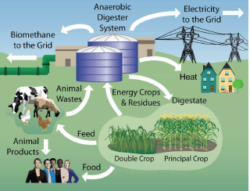Beyond food waste: the potential for regional circular biowaste economies

By Dr John Lever, Reader at Department of Management, Huddersfield Business School, and Director of the Centre for Sustainability, Responsibility, Governance and Ethics.
The UK food system is characterised by various subsidies and incentives that encourage a wide range of supply chain actors to send food and other biowastes (biodegradable, organic materials) to anaerobic digestion and incineration facilities to produce energy. Although supermarkets and retailers send a small percentage of their ‘food surplus’ to people experiencing ‘food poverty’ via charities such as FareShare, research suggests that they only redistribute food (which has a higher priority on the national waste hierarchy) in the absence of profitable ways of using food waste to produce energy. Much as there are for supermarkets, there are also incentives for farmers to send organic waste to anaerobic digestion for energy generation. Many farms now grow energy crops specifically for this purpose because it is more profitable than producing food for supermarkets. Energy production thus dominates the food and biowaste waste agendas, although the forms of energy produced often ‘crowd out’ more environmentally friendly alternatives such as wind and solar.
These issues were evident in a recent study into the operation of regional food systems in West Yorkshire, and it soon became clear that local authorities play ‘pig in the middle’ in the food and waste markets. Very often, they are tasked with redistributing surplus supermarket food to people experiencing ‘food poverty’ via national food policies that continue to prioritise the overproduction and consumption of cheap food. When they lack the capacity to redistribute surplus food, our research found that in the absence of regional AD capacity local authorities often send it to incineration to maintain the reduction of the volumes of food sent to landfill as waste. These ‘linear’ practices are quite widespread in low-income areas such as Huddersfield in North Kirklees and they have doubled nationally in recent years.

Source: https://www.ieabioenergy.com/blog/publications/new-publication-integration-of-anaerobic-digestion-into-farming-systems-in-australia-canada-italy-and-the-uk/
Farmers and other regional food business also complained about the lack of viable markets for food and biowaste, and many suggested that enforcement by the Department for Environment, Food and Rural Affairs (DEFRA), Environmental Health and the Food Standards Agency (FSA), among others, can be overly strict. Negotiating the value of new organic biowaste streams for regional businesses can be difficult and it appears that circular food practice is often linked solely to development technology and novel food products. There are obvious historical reasons for this impasse, but with biowaste constituting the UK’s largest waste stream (5 million tonnes go to landfill annually), the development opportunities for struggling regional economies in the North of England to make a direct contribution to wider development goals are clear. Sustainable biological resources are capable of providing direct replacements for fossil resources in a range of products, processes and services.
With the collection of higher quality (separated) food waste from households becoming mandatory at the local authority level by 2023, this development potential is growing. However, local authorities are again stuck in the middle and many are finding it hard to develop waste strategies in line with the demands and uncertainties of England’s new resources and waste strategy. Coupled with the progression of Environment Bill and the potential for more commercial food waste to enter the market, current regional infrastructure could be stretched beyond capacity. The prospect of missing the opportunity to develop circular regional biowaste products and markets, even in largely urban regions such as West Yorkshire, is also growing, as is the likelihood of expanding the production of energy through anaerobic digestion and incineration over and above much needed circular bio products with more valuable social, economic and environmental outcomes. Better policy coordination across Government is an urgent priority if regional economic innovation is to contribute to development goals at the national and global level. For more information on our research see: Covid-19 Policy Brief: A Regional Approach to Food System Reform.
